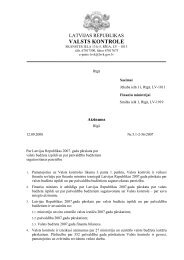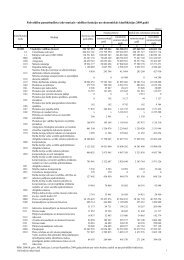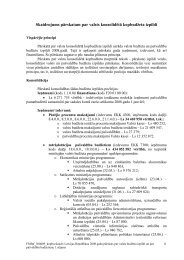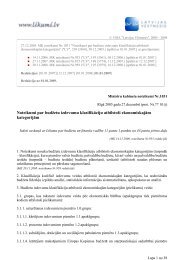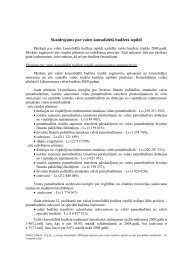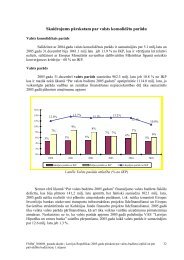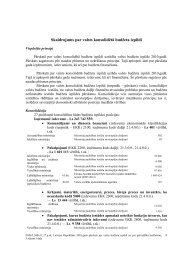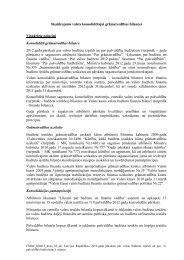Update Presentation
Update Presentation
Update Presentation
You also want an ePaper? Increase the reach of your titles
YUMPU automatically turns print PDFs into web optimized ePapers that Google loves.
<strong>Update</strong> <strong>Presentation</strong><br />
the Republic of Latvia<br />
April 2010
<strong>Presentation</strong> Overview<br />
1. Overview and Latvia’s Fundamental Strengths 3<br />
2. Impact of the Crisis and the Government’s Response 7<br />
3. Initial Success 12<br />
4. Government Debt and Funding Strategy 19<br />
5. Conclusions 26
1. Overview and Latvia’s Fundamental Strengths
Latvia Overview<br />
<br />
<br />
Territory: 64,559 sq km<br />
Population: 2.3 million<br />
Capital: Riga (population: 0.7 million)<br />
Exchange rate: Latvian lat pegged to € since 2005<br />
– YTD LVL/€ (average): 0.7028<br />
– YTD LVL/$ (average): 0.5150<br />
GDP: LVL 13,244 million/ LVL 5,874 per capita (as of 2009)<br />
Credit ratings: Moody’s: Baa3 // S&P: BB // Fitch: BB+<br />
Main economic sectors:<br />
<br />
<br />
<br />
4<br />
– Services (69.3% of GDP in 2009): logistics, IT, financial, trade<br />
– Manufacturing (8.7% of GDP in 2009): wood, metal, textile,<br />
chemicals, pharmaceutical<br />
Foreign trade:<br />
– Export: wood products, metal, chemicals, mechanical appliances,<br />
food<br />
– Import: mineral products, equipment, vehicles<br />
– Main trade counterparts<br />
– Import: EU (Lithuania, Germany, Estonia, Poland), Russia<br />
– Export: EU (Lithuania, Estonia, Germany, Sweden), Russia<br />
Life quality indicators:<br />
– Life expectancy: 72.5 years (avg, 2008)<br />
– Internet users: 60.9 per 100 inhabitants (2009)<br />
– Retirement age: 62 years<br />
– Average gross monthly salary: 461 LVL (2009)<br />
Politics:<br />
– Centre-right coalition headed by PM Valdis Dombrovskis<br />
– President Valdis Zatlers<br />
– October 2010: next parliamentary elections
Fundamentals Supporting Long-Term Growth<br />
A competitive and developed economy with a proven attractiveness to investors<br />
World Bank ‘Ease of Doing Business 2010’ Survey<br />
Foreign Investment<br />
Singapore<br />
United States<br />
Estonia<br />
Lithuania<br />
Latvia<br />
France<br />
Slovakia<br />
Bulgaria<br />
Hungary<br />
Portugal<br />
Slovenia<br />
Romania<br />
Spain<br />
Poland<br />
Italy<br />
Croatia<br />
1<br />
4<br />
24<br />
26<br />
27<br />
31<br />
42<br />
44<br />
47<br />
48<br />
53<br />
55<br />
62<br />
72<br />
78<br />
Ranked 27 th (out of 183)<br />
globally by the World<br />
Bank on ease of doing<br />
business<br />
103<br />
Cumulative FDI (LVL million)<br />
6000<br />
5000<br />
4000<br />
3000<br />
2000<br />
1000<br />
Latvia has attracted<br />
strong foreign<br />
investment over the<br />
years<br />
In terms of business<br />
friendly environment,<br />
Latvia is ranked by<br />
the World Bank¹<br />
among:<br />
− The top 3 CEE<br />
countries<br />
− Top 30 globally<br />
by the World<br />
Bank<br />
¹ ‘Ease of Doing Business 2010 Survey<br />
Russia<br />
120<br />
Brazil<br />
Ukraine<br />
Source: World Bank<br />
129<br />
142<br />
0 25 50 75 100 125 150<br />
Global Rank<br />
0<br />
2004 2005 2006 2007 2008 2009<br />
Cumulative FDI stock in equity capital<br />
Cumulative FDI stock in other capital<br />
5<br />
Source: Bank of Latvia
EU Fund Transfers<br />
Latvia has been a substantial recepient of EU fund transfers, which has supported foreign fund<br />
inflows<br />
Inflow of EU Funds<br />
Support Field Cumulative (LVL Million) (1) Total<br />
Pre-accession funds (2) 115.1 5.1%<br />
Structural funds (3) 797.0 35.1%<br />
Cohesion policy (4) 548.7 24.1%<br />
Common agricultural policy (5) 698.3 30.7%<br />
Transition policy 64.1 2.8%<br />
Other funds 42.1 1.9%<br />
Non-EU facilities 18.5 0.8%<br />
Repaid to EU -10.5 -0.5%<br />
Total LVL 2,273.4mn 100%<br />
(1) From 1 January 2004 to 31 March 2010<br />
(2) Pre-accession funds help to finance a Member State's expenditure on conforming its laws to the existing body of European<br />
Community law and on development in general.<br />
(3) Structural funds allow the EU to grant financial assistance to help resolve a Member State's structural economic and social<br />
problems.<br />
(4) Cohesion policy funds are designed to offset the burden of the single market for the less-favoured Member States or regions of<br />
Member States.<br />
(5) Common agricultural policy funds represent agricultural subsidies paid to a Member State.<br />
Source: The Treasury<br />
Cumulative (LVL Million) (2)<br />
Total<br />
Current expenditure 1,773.2 78%<br />
Capital expenditure 480.8 21%<br />
Funds received but not yet spent 19.4 1%<br />
Total LVL 2,273.4mn 100%<br />
(1) Without state co-financing<br />
(2) From 1 January 2004 to 31 March 2010<br />
6<br />
Use of EU Funds (1)<br />
Note: calculated based on statistical assumptions used in EDP (Excessive Deficit Procedure) tables prepared for Eurostat<br />
Source: The Treasury<br />
Breakdown of Jan-Mar, 2010 Inflow of EU Funds (LVL 195.6mn)<br />
Non-EU Facilities<br />
2,8%<br />
Other Funds<br />
1,2%<br />
Common<br />
Agricultural Policy<br />
33,0%<br />
Source: The Treasury<br />
Structural Funds<br />
28,2%<br />
Cohesion Policy<br />
34,9%<br />
Latvia's own resource payments to the EU<br />
Cumulative (LVL Million) (1)<br />
Total<br />
GNI (2) 476.6 64.9%<br />
VAT (3) 106.0 14.4%<br />
UK correction (4) 56.9 7.8%<br />
Traditional own resources (5) 94.5 12.9%<br />
Agricultural levies 5.0 0.7%<br />
Custom duties 86.4 11.8%<br />
Sugar levies 3.1 0.4%<br />
Total LVL 734.0mn 100%<br />
(1) From 1 May 2004 to 31 March 2010<br />
(2) Gross National Income, charged at a uniform rate of 0.73 per cent. of each Member State's gross national income<br />
(3) Charged at 0.3 per cent. of Latvia's VAT revenue (harmonised to reflect VAT rate differences between Member States)<br />
(4) Reflecting Latvia's contribution to the EU compensation paid to the UK in respect of its lower agricultural fund receipts<br />
(5) This represents duties that are charged on imports of relevant products into Latvia from a non-EU state.<br />
Source: The Ministry of Finance
2. Impact of the Crisis and the Government’s Response
EU Membership, Acceleration of Growth, and the Impact of the Crisis<br />
EU membership in 2004 marked a turning point<br />
EU Membership<br />
Acceleration of Growth<br />
Impact of the Crisis<br />
<br />
Growth of trade accelerated<br />
<br />
From 2004 to 2007 trade grew at<br />
a compound annual growth rate<br />
of 15.3%<br />
<br />
Investment grew much more rapidly<br />
than savings<br />
Gross fixed capital grew by over<br />
90%* between 2004 and 2007<br />
<br />
<br />
Contraction in GDP<br />
<br />
GDP contracted sharply due to<br />
the economic crisis, 18% in 2009<br />
Increase in unemployment<br />
<br />
<br />
<br />
Capital inflows rose sharply<br />
<br />
From 2004 to 2007 FDI grew at a<br />
compound annual growth rate of<br />
31%<br />
Productivity in industry improved<br />
Between 2004 and 2007<br />
Industrial output increased by<br />
over 20%<br />
GDP per capita rose substantially<br />
<br />
Over the same period real GDP<br />
per capita grew by 38.7%<br />
<br />
<br />
<br />
Current account deficit rose sharply<br />
Latvia’s current account deficit<br />
reached 22.3% of GDP in 2007<br />
External debt grew to an unsustainable<br />
level<br />
Private sector credit as a proportion<br />
of nominal GDP grew by 76%<br />
between 2004 and 2007<br />
Inflation accelerated<br />
Annual average CPI rose by 6.2%<br />
to 10.1% between 2004 and 2007<br />
<br />
<br />
<br />
Having fallen for a number of<br />
years, unemployment has spiked<br />
in 2009-2010<br />
Government’s fiscal position<br />
<br />
Despite the historical fiscal<br />
prudence, lower tax revenues<br />
have impacted government<br />
finances<br />
Central Government Debt<br />
<br />
Govt debt has increased, although<br />
is still very low when compared to<br />
EU peers<br />
*Note: using the expenditure method<br />
The emerging imbalances were intensified by the onset of the global recession<br />
8<br />
Source: The Treasury, Central Bank
The Government’s Response to the Crisis<br />
Summary of Objectives<br />
Overview of the Response<br />
Immediate Priorities<br />
Address the liquidity crisis<br />
Ensure long-term external stability<br />
Maintaining fixed exchange rate<br />
Long-Term Stabilisation through fiscal adjustment measures<br />
Readjust public debt levels to a decreasing and sustainable path<br />
Progressively narrow budget deficits in line with IMF and EU targets<br />
Achieve 3% of GDP budget deficit by 2012<br />
Public finances to be ready for Eurozone entry<br />
Stimulating economic growth<br />
Realise long-term growth by implementing further structural reforms<br />
Stimulating economic activity and improving competitiveness<br />
Banking sector stability<br />
Place the banking system on a stable footing with a solid capital base<br />
Increase depositor and creditor confidence<br />
Restoring confidence<br />
Improve perception of Latvia in the eyes of foreign investors<br />
Restore confidence of international financial markets<br />
Maintain transparency while carrying out the reforms<br />
Use of international support<br />
<br />
<br />
<br />
Total €7.5bn of loans, including from IMF, EU, Nordic countries, EBRD &<br />
other bilateral lenders out of which €4 bn have already been drawn (end<br />
of March 2010)<br />
Sufficient external funding to cover near term financing needs<br />
Currency stabilised and fixed exchange rate maintained<br />
Major fiscal reforms<br />
<br />
<br />
<br />
Tax reform and expenditure cuts initiated with the 2009 Budget<br />
2009 Supplementary Budget: further tax increases, expenditure cuts,<br />
including pensions and social benefits<br />
2010 Budget plans cements the fiscal consolidation<br />
Wide-ranging structural reforms<br />
<br />
<br />
Multi-phased pension expenditure cut<br />
Substantial reforms in healthcare and education systems<br />
Recapitalisation and reform<br />
<br />
<br />
Largest Scandinavian banks have provided their long-term commitment<br />
and support to Latvia<br />
The role of the financial sector regulator has been strengthened<br />
Consistent economic policy and commitment to Eurozone entry<br />
<br />
Swift implementation of the crisis management measures<br />
Commitment to adoption of the Euro by 2014<br />
The Government is committed to the implementation of its recovery package, despite the<br />
potentially painful adjustments in the short-term<br />
9
Latvia’s Fiscal Strategy: 2009 and 2009 Supplementary Budgets<br />
The Government has responded early and decisively by implementing substantial fiscal<br />
consolidation measures and expenditure cuts supported by social partners<br />
Expenditure Cuts<br />
Public Administration<br />
• Number of employees reduced<br />
• Average monthly salary reduced by 20%<br />
• Average remuneration reduction by more than 30% (bonuses<br />
not paid, supplements, compensations and allowances<br />
restricted)<br />
• Reduction of number of agencies (from 76 to 39 agencies)<br />
• Centralization of support functions (accounting, IT<br />
maintenance, public relations, personnel management)<br />
Education (since September 2009 a new financing model is<br />
introduced “money follows student” model, optimizing school<br />
network, increasing the number of students per workload)<br />
Health Care (establishment of effective network of health care<br />
service providers, reduction of the hospitals from 59 to 42,<br />
budget expenditure is reduced by 0.6% of GDP in 2009 )<br />
<br />
<br />
<br />
<br />
<br />
Revenue Increase<br />
VAT increased from 18% by 3% to 21%; the reduced rate from 5% to<br />
10%; reduction of number of goods subject to reduced VAT rate<br />
Increase of excise tax on alcohol, tobacco, fuel, non-alcoholic<br />
beverages, coffee<br />
Increase of gambling taxes<br />
Increase in dividend pay-out rates from state owned companies<br />
Monthly personal income tax allowance reduced from LVL90 to LVL35<br />
Fiscal Targets 1<br />
<br />
Budget deficits targeted to be<br />
- 2009: Below 10% of GDP<br />
- 2010: Below 8.5% of GDP<br />
- 2011: Below 6% of GDP<br />
- 2012 and beyond: Below 2.9% of GDP<br />
10<br />
<br />
Government will continue adjustments every year until the budget<br />
deficit is below the 3% of GDP Maastricht threshold<br />
1. According to ESA95 methodology
2010 Budget <strong>Update</strong><br />
<br />
Expenditure Cuts<br />
Decrease in remuneration of public sector employees<br />
Average monthly salary reduction by 5%<br />
<br />
<br />
<br />
In the 2010 Budget, the Government intends to focus both on revenue increase and expenditure<br />
reduction for reducing the fiscal deficit<br />
<br />
Reduction of administrative costs of ministries<br />
Review of subsidies and grants, capital costs and transfers for<br />
municipalities have been decreased<br />
As well as:<br />
– public procurements decreased<br />
– implementation of investment projects revised<br />
These measures are designed to reduce expenditures by around<br />
LVL 244.6 million<br />
Raise of PIT rate from 23% to 26%<br />
<br />
<br />
<br />
<br />
<br />
<br />
<br />
<br />
<br />
<br />
Broadening of PIT base including all capital income with tax rate of<br />
15% (dividends and interest are taxed with rate 10%)<br />
Set a minimal level of excise duty<br />
Increase the excise duty on wine and fermented beverages and<br />
increase the excise duty on fermented beverages with absolute alcohol<br />
content up to 15 per cent<br />
Increase of tax on cars<br />
Revenue Increase<br />
Increase the annual fee on transport vehicles<br />
Taxation of fringe benefit from using employer car for employee'<br />
personal needs<br />
Introduction of a new excise tax on natural gas<br />
Increase of real estate tax rate form 1 to 1.5% on land and buildings<br />
used for business activities<br />
Introduction of a new real estate tax on residential buildings (including<br />
progressivity (rate from 0,1% to 0,3% depending on cadastral value),<br />
broadening of real estate tax base including civil engineering<br />
structures<br />
These measures are designed to increase revenues by around LVL<br />
262.9 million<br />
Fiscal Targets for 2010<br />
11<br />
<br />
<br />
Consolidated general government deficit/ projected nominal GDP: below<br />
8.5% of GDP<br />
Fiscal consolidation – 507.5 million lats: revenue – 262.9 or 2.2% of GDP<br />
and expenditure – 244.6 million lats or 2.1% of GDP
Economic Stimulus<br />
Economic growth • Credit guarantees (Latvian Guarantee Agency), till May’10 153 guarantees issued, in amount of 66<br />
mn EUR; Rural Development Fund guarantees for agricultural companies in amount of LVL44 mn<br />
Improving competitiveness<br />
<br />
Latvian Mortgage and Land bank’s support programme for SMEs, Ministry of Economy programme<br />
for promotion of business competitiveness and innovation in 2007-2013<br />
Labour market Activities to improve labour elasticity and competitiveness<br />
EU funds<br />
<br />
2007-2013 funding allocation to export and infrastructure projects, business development;<br />
accelerating EU fund allocation; reducing administrative borders; fund reallocation;<br />
Export support<br />
Export guarantees (Latvian Guarantee Agency), till May 20 th (2010), LGA has issued 36<br />
guarantees, total amount of guarantees 2.2 mn LVL; export credit insurance<br />
Resource effectiveness Heating energy saving for houses and centralized heat supply systems<br />
Entrepreneurship support<br />
<br />
Reduction of legal barriers for registration of real estate, construction, tax administration easening;<br />
reduction of administrative barriers for company registration<br />
Review of planned EU Funds’ activities<br />
Support for SMEs through Mortgage and Land Bank (available amounts)<br />
Objective: to find the most eligible way for implementation of the<br />
EU Funds in the context of economic crises<br />
Process: reviewed 85 of 150 EU Funds’ activities for 1’069 million<br />
EUR (20% of total allocation of public funding for 2007-2013)<br />
Result: reallocation of funding to the activities which would have<br />
the most positive impact on the recovery of national economy<br />
Start-up capital: LVL17 mn till 2013 (LVL1.7 mn issued)<br />
Microcredits for SMEs: LVL0.565 mn till 2010<br />
Improving competitiveness: LVL128.9 mm till 2013 (LVL119.7 mn issued)<br />
Loans to SMEs and agricultural companies: LVL70.3 mn till Oct-2011 (LVL3.4 mn issued)<br />
Loans to ensure current assets for agricultural products producing companies: LVL10 mn<br />
till 2011<br />
12<br />
Source: Ministry of Economics
Structural Reforms to Support Sustainable Recovery<br />
Education<br />
Pension Reforms<br />
<br />
<br />
Policy development based on negative demographic trends, new financing model - “money follows<br />
student”, plan for optimisation of the vocational education institution network for 2010–2015<br />
In 2010, it is planned to define necessary changes to the pension system to ensure financial<br />
stability of the pension system in medium and long term.<br />
Healthcare<br />
• Improving management of the healthcare system, reduction of the hospitals from 59 to 42,<br />
promotion of home care, development of the Emergency Medical Assistance Service<br />
Public Administration<br />
<br />
Wage reduction, reduction of employees in central state institutions, reduction of the number of<br />
agencies (from 76 to 39 agencies), centralisation of support functions<br />
Financial System • Banking system recapitalised, role of regulator strengthened, deposit guarantee laws streamlined<br />
To mitigate some of the recent policy responses, the Government in close corperation with World Bank has designed a comprehensive<br />
social safety net<br />
Implementation of the Social Safety Net<br />
Specific activities are foreseen for the domains of:<br />
welfare (Guaranteed Minimum Income increase; provision of housing benefit; Emergency social employment program),<br />
education (provision of education for children aged 5-6; provision of transport to schools for pupils from areas where schools have been closed down as a<br />
result of the education reform),<br />
transportation (compensation of losses to public transportation providers for transportation of particular socially vulnerable groups of people) and<br />
health (compensation mechanism to cover the patient copayments for needy persons, medication for needy patients, accommodation expenses for needy<br />
persons, provision of home care to needy persons with serious diseases; concentration of in-patient services to needy persons with mental diseases by<br />
decreasing the number of beds and developing day care centres).<br />
2010 State budget foresees financing for these activities in amount of LVL 56 645 569<br />
Latvian Strategic Development Plan 2010–2013 is approved by government setting key<br />
priorities and courses of action for economic growth and promoting social security, as well as<br />
13<br />
for improving efficiency of public administration
3. Initial Success
The Economy Is Already Adjusting and Reserves Have Recovered<br />
Taking Place<br />
15<br />
10<br />
5<br />
0<br />
-5<br />
-10<br />
-15<br />
-20<br />
-25<br />
Source: Bank of Latvia<br />
25<br />
20<br />
15<br />
10<br />
5<br />
0<br />
-5<br />
-10<br />
-12,8 -12,5<br />
2,4<br />
9,7<br />
Source: Central Statistical Bureau of Latvia<br />
Current Account (% of GDP) Inflation (%)<br />
-22,5 -22,3<br />
2004 2005 2006 2007 2008 2009<br />
Real Wages (Y-o-Y % change)<br />
15,6<br />
19,9<br />
6,2<br />
-5,6<br />
2004 2005 2006 2007 2008 2009<br />
-13<br />
9,4<br />
The CA has<br />
swung into<br />
surplus in<br />
2009 for the<br />
first time in<br />
a number of<br />
years<br />
Downward<br />
pressure on<br />
wages should<br />
further boost the<br />
competitiveness<br />
of the economy<br />
Source: Central Statistical Bureau of Latvia<br />
4 000<br />
3 500<br />
3 000<br />
2 500<br />
2 000<br />
1 500<br />
1 000<br />
500<br />
6,2 6,7 6,5<br />
Foreign Exchange Reserves (LVLm)*<br />
After reaching<br />
a peak in<br />
2008, inflation<br />
has reduced<br />
by 15<br />
percentage<br />
points to 0.3%<br />
Forex<br />
reserves have<br />
stabilized as,<br />
among others,<br />
substantial<br />
EU/IMF funds<br />
have been<br />
received<br />
0<br />
2005 2006 2007 2008 2009 2010<br />
* Net foreign assets equals convertible<br />
Source: Bank of Latvia<br />
Net foreign assets Monetary base foreign currency and gold reserves<br />
The current account deficit has shifted substantially to a sizeable surplus, inflation and wages<br />
15<br />
have fallen and FX reserves have stabilised<br />
20<br />
16<br />
12<br />
8<br />
4<br />
0<br />
10,1<br />
15,4<br />
2004 2005 2006 2007 2008 2009 Mar-10<br />
3,5<br />
0,3
Initial Success already Evident<br />
Spending Cuts<br />
Enacted<br />
Earlier spending cuts have had the desired effect, enabling the<br />
reduction of fiscal imbalances<br />
Fiscal Targets<br />
Met<br />
The government is on track to meet its budget deficit target as<br />
agreed with the IMF/EU<br />
Extra Funds<br />
Secured<br />
Additional external funding has been obtained from the World<br />
Bank, the IMF and the EU<br />
Confidence is<br />
Returning<br />
Recent domestic debt auctions and tightening of sovereign credit<br />
spreads show a return in investor confidence, credit rating<br />
stabilising<br />
The Government’s measures are already showing signs of success, with an improving fiscal<br />
position and the return of investor confidence<br />
16
Central government budget consolidation – expenditure reduction<br />
Central government revenue and expenditure, mln lats<br />
Several central government budget expenditure categories,<br />
mln lats<br />
6 000<br />
1800<br />
1600<br />
5 000<br />
1400<br />
4 000<br />
1200<br />
3 000<br />
Revenue<br />
1000<br />
800<br />
Social benefits<br />
Remuneration<br />
2 000<br />
Expenditure<br />
600<br />
400<br />
Capital expenditure<br />
1 000<br />
200<br />
-<br />
Execution of<br />
2008<br />
Execution of<br />
2009<br />
Plan of 2010<br />
0<br />
Execution of<br />
2008<br />
Execution of<br />
2009<br />
Plan of 2010<br />
17
Budget execution in 2009 and 1Q2010<br />
10%<br />
Budget Execution in 2009<br />
9%<br />
8%<br />
7%<br />
6%<br />
5%<br />
4%<br />
3%<br />
6,4% 6,8%<br />
9,0%<br />
• According to EU methodology<br />
(ESA 95) general government<br />
deficit in 2009 was 9.0% of GDP<br />
– lower than 10% deficit limit set<br />
by lenders.<br />
2%<br />
1%<br />
0%<br />
Central government deficit<br />
(% of GDP)*<br />
* On cash-flow basis<br />
General government deficit<br />
(% of GDP)*<br />
General government deficit<br />
by ESA95 (% of GDP)<br />
Budget Execution in 1Q’2010<br />
<br />
<br />
<br />
<br />
General government deficit target for 2010 - 8,5% of GDP (on ESA terms)<br />
General government budget revenues in 1Q of 2010 were 5.7% less than in the same period of 2009, mainly due to<br />
decrease of central government basic budget tax revenue; and expenditure were 5.8% less<br />
As a result of better performance of VAT (by 20,4%) and corporate income tax (by 16,5 %) the state basic budget tax<br />
revenues were higher by 7,4 % ( 26,6 million lats) than expected in the 1Q. However excise tax on tobacco has given by<br />
37, 8% less income in the budget as planned<br />
General government budget deficit in 1Q of 2010 was 1.1% of GDP according to national methodology. Central<br />
government deficit was 1,5 % of GDP<br />
18
4. Government Debt and Funding Strategy
115,8<br />
Italy<br />
Low Public Debt and Prudent Debt Management<br />
Latvia has remained committed to keeping government debt at moderate levels…<br />
Government debt is amongst the lowest in the EU<br />
Conservative debt management policy has kept government debt at moderate levels over the past decade<br />
Government debt is well within the Maastricht limit of 60% of GDP<br />
General government debt at the end of 2009 was 36.1% of GDP<br />
General Government Debt (% of GDP, ESA 95 methodology, 2009-4th quarter)<br />
140<br />
7,2<br />
14,5<br />
14,8<br />
23,7<br />
29,3<br />
35,4<br />
35,7<br />
35,9<br />
36,1<br />
41,5<br />
42,3<br />
44,0<br />
51,0<br />
53,2<br />
56,2<br />
60,9<br />
64,0<br />
66,5<br />
68,1<br />
69,1<br />
73,2<br />
73,6<br />
76,8<br />
77,5<br />
78,3<br />
96,7<br />
115,1<br />
120<br />
100<br />
80<br />
60<br />
40<br />
20<br />
% of GDP<br />
The 9th lowest<br />
Debt to GDP<br />
ratio in the EU<br />
0<br />
Estonia<br />
Luxembourg<br />
Bulgaria<br />
Romania<br />
Lithuania<br />
Czech Republic<br />
Slovakia<br />
Slovenia<br />
Latvia<br />
Denmark<br />
Sweden<br />
Finland<br />
Poland<br />
Spain<br />
Cyprus<br />
Netherlands<br />
Ireland<br />
Austria<br />
United Kingdom<br />
Malta<br />
Germany<br />
EU-27<br />
Portugal<br />
France<br />
Hungary<br />
Belgium<br />
Greece<br />
20<br />
…thus being in a position to comfortably absorb the full impact of the crisis
The Treasury’s Financing and Liquidity Strategy<br />
The Treasury’s borrowing strategy has been focused on maintaining high levels of liquidity<br />
<br />
<br />
<br />
The Treasury’s liquidity position stands currently at its historically highest<br />
level<br />
Main part of the International lenders’ money is considered as a reserve<br />
or liquidity buffer<br />
Currently financing requirement is covered mainly by domestic securities<br />
issues (that is being rolled over)<br />
1 800<br />
1 600<br />
1 400<br />
1 200<br />
1 000<br />
Balance of Resources (Million LVL)<br />
Received 3rd<br />
tranches<br />
from EC and<br />
IMF<br />
1,578<br />
800<br />
600<br />
400<br />
200<br />
0<br />
LVL million<br />
5 000<br />
4 000<br />
3 000<br />
2 000<br />
1 000<br />
0<br />
-1 000<br />
-2 000<br />
-1 401 -1 286 -1 227<br />
2010 (1) 2011 2012<br />
Total central government financing requirement<br />
Financing requirement forecast and associated funding<br />
2 004<br />
1 578<br />
2010-end<br />
2011-end 2 643<br />
1 337<br />
Liquidity Buffer 1 125<br />
Liquidity Buffer<br />
LVL 2,004 mn<br />
LVL 2,643 mn 0<br />
490 800 800<br />
Domestic securities issues<br />
2012-end<br />
Liquidity<br />
Buffer<br />
LVL2,216<br />
mn<br />
Jan-06<br />
Mar-06<br />
May-06<br />
Jul-06<br />
Sep-06<br />
Nov-06<br />
Jan-07<br />
Mar-07<br />
May-07<br />
Jul-07<br />
Sep-07<br />
Nov-07<br />
Jan-08<br />
Million LVL 2010 (1) 2011 2012<br />
Total central government financing<br />
requirement (incl. refinancing of forecasted<br />
T-bills)<br />
Mar-08<br />
May-08<br />
Jul-08<br />
Sep-08<br />
Nov-08<br />
Jan-09<br />
Mar-09<br />
May-09<br />
Jul-09<br />
Sep-09<br />
Nov-09<br />
Jan-10<br />
(1,401) (1,286) (1,227)<br />
Planned funding activities 1,827 1,925 800<br />
Domestic securities gross issues 490 800 800<br />
International support 1,337 1,125 0<br />
Total Treasury balance (at year end) 2,004 2,643 2,216<br />
i.a. earmarked for banking sector<br />
support<br />
456 - -<br />
Mar-10<br />
21<br />
International support<br />
Cash balance (at the end of previous period)<br />
(1) April-December
Strong and Broad-Based International Support<br />
Tough adjustment measures have earned international financial support for Latvia<br />
Planned Assistance<br />
(€ Million) 2009 2010 2011 Total<br />
EU 2,200 700 200 3,100<br />
Nordic Countries<br />
(SE, DK, FI, NO, EE)<br />
- 1,000 900 1,900<br />
IMF 800* 500 400 1,700<br />
World Bank 200 200 - 400<br />
Other (CZ, PL, EBRD) 100 200 100 400<br />
Total 3,300 2,600 1,600 7,500<br />
* EUR 600 mn in December 2008<br />
Other<br />
€400mln<br />
5%<br />
IMF<br />
€1,700mln<br />
23%<br />
WB<br />
€400mln<br />
5%<br />
Breakdown by Institution<br />
EU<br />
€3,100mln<br />
42%<br />
<br />
<br />
<br />
<br />
Loans Disbursed to Date<br />
(€ Million) Disbursed Date Disbursed<br />
EU<br />
IMF<br />
EBRD<br />
World<br />
Bank<br />
First Tranche 1000 February 2009<br />
Second Tranche<br />
Third Tranche<br />
1200<br />
500<br />
August 2009<br />
March 2010<br />
First Tranche 600 December 2008<br />
Second Tranche<br />
200<br />
July 2009<br />
Third Tranche<br />
Investment in Parex bank &<br />
subordinated loan<br />
200<br />
February 2010<br />
100 September 2009<br />
First Tranche 200 November 2009<br />
Total 4,000 -<br />
The various financial assistance packages represent a total of<br />
€7.5 billion in loans<br />
As part of the assistance package, Latvia has committed to<br />
implement an economic reform programme<br />
Latvia’s assistance package is small relative to the resources<br />
available to the institutions providing the support<br />
Both the EU and the IMF have disbursed the third tranches of<br />
their respective loans following successful economic and other<br />
reform measures implemented by the government in the 2010<br />
budget in accordance with these agreements<br />
22<br />
Nordic Countries<br />
€1,900mln<br />
25%<br />
EU/IMF review mission is planned in May 2010<br />
Source: Treasury, IMF, EU
Return of Investor Confidence<br />
16<br />
14<br />
12<br />
10<br />
Recent demand for domestic debt and recovery in credit spreads underpins investors’<br />
confidence in Latvia’s recovery <br />
Average Weighted Yields at Domestic T-bills Competitive Multiprice Auctions<br />
%<br />
<br />
<br />
<br />
Latvia’s recovery has been further<br />
boosted by the return of regular<br />
domestic debt auctions<br />
Since June 2009 the Treasury has<br />
steadily been increasing the average<br />
maturity of its domestic securities<br />
portfolio by issuing longer dated<br />
securities<br />
Average weighted yield rates have<br />
markedly decreased over the last<br />
quarter of 2009 and 1st quarter of 2010<br />
Credit spreads on Latvia’s Eurobond<br />
have substantially rallied, tightening by<br />
around 240bps since their highs<br />
23<br />
8<br />
6<br />
4.712%<br />
4<br />
3.038%<br />
2<br />
0<br />
Jan-09 Mar-09 May-09 Jul-09 Sep-09 Nov-09 Jan-10 Mar-10<br />
1M 3M 6M 12M 2Y 3Y<br />
Source: The Treasury.<br />
5.933%<br />
5.093%<br />
3.18%<br />
1.804%<br />
Spread vs MS (bps)<br />
700<br />
650<br />
600<br />
550<br />
500<br />
450<br />
400<br />
350<br />
300<br />
250<br />
Eurobond 2018 Performance<br />
200<br />
Nov-<br />
08<br />
Jan-<br />
09<br />
Mar-<br />
09<br />
May-<br />
09<br />
Jul-<br />
09<br />
Sep-<br />
09<br />
Nov-<br />
09<br />
Jan-<br />
10<br />
Mar-<br />
10<br />
Source: Bloomberg
Extended Maturity Profile and Decreasing Rates<br />
Domestic T-Bill Competitive Multi-price Auctions in January-April 28, 2010<br />
24<br />
mn, lats<br />
25<br />
20<br />
15<br />
10<br />
5<br />
0<br />
Source: The Treasury.<br />
10 years<br />
26%<br />
Source: The Treasury.<br />
5 years<br />
16%<br />
11 years<br />
4%<br />
28 days<br />
4% 91 days<br />
10%<br />
364 days<br />
24%<br />
182 days<br />
16%<br />
2010 Jan-Apr 28:<br />
LVL251.22 mn<br />
3-m<br />
6-m<br />
12-m<br />
3-m<br />
6-m<br />
12-m<br />
6-m<br />
12-m<br />
6-m<br />
12-m<br />
6-m<br />
12-m<br />
6-m<br />
12-m<br />
6-m<br />
12-m<br />
6-m<br />
12-m<br />
2-y<br />
6-m<br />
12-m<br />
6-m<br />
12-m<br />
2-y<br />
6-m<br />
12-m<br />
2-y<br />
6-m<br />
12-m<br />
6-m<br />
12-m<br />
12-m<br />
3-y<br />
6-m<br />
12-m<br />
January February March April<br />
Amount sold (LHS) Bid-cover Ratio (RHS)<br />
Bid-to-Cover ratio: Bid Amount to State Treasury offered amount<br />
Domestic Securities outstanding at the 2nd quarter, 2009 and as of 30 Apr, 2010<br />
10 years<br />
24%<br />
5 years<br />
9%<br />
3 years<br />
2%<br />
2 years<br />
6%<br />
11 years<br />
4%<br />
182 days<br />
23%<br />
364 days<br />
32%<br />
5,0<br />
4,0<br />
3,0<br />
2,0<br />
1,0<br />
0,0<br />
Ratio<br />
Funding shifts away from<br />
short term bills to medium<br />
term bonds while average<br />
yields decrease<br />
<br />
<br />
<br />
In 2010 the government has<br />
successfully completed 17<br />
auctions of 3m, 6m, and 12m<br />
T-Bills and 2y and 3y T-bonds<br />
raising over LVL250mn in<br />
competitive multiprice auctions<br />
and LVL 355mn in total<br />
(competitive multiprice and<br />
non-competitive domestic<br />
securities auctions).<br />
As of 30 th June 2009, T-Bills<br />
maturing in 28-days<br />
represented 4% of total<br />
portfolio<br />
By 30 April 2010, the Treasury<br />
achieved the following:<br />
– No 28-day and 91-day<br />
T-Bills were<br />
outstanding<br />
– The share of 182 day<br />
T-Bills was increased<br />
from 16% to 23%<br />
– 6% and 2% of 2-year<br />
and 3-year bonds<br />
outstanding
Government Debt Profile<br />
Modest government debt redemptions in the short-term<br />
<br />
<br />
<br />
25<br />
Latvia faces minimal government external debt repayments in the<br />
next two years<br />
– As 97% of 2010-2011 debt repayments are represented by<br />
domestic debt, refinancing risk is minimal especially given<br />
the recent successes in terms of domestic debt auctions<br />
The largest portion of external government debt is now<br />
represented by the recent EU and IMF loans which were incurred<br />
since the start of the crisis<br />
Eurobonds outstanding in amount of €800mn (2 issues) as of<br />
31 st Mar. 2010<br />
– €400mn due in April 2014<br />
– €400mn due in March 2018<br />
External Govt. Debt Breakdown (31st Mar 2010)<br />
Source: The Treasury.<br />
Eurobonds<br />
15%<br />
World Bank<br />
4%<br />
NIB<br />
3%<br />
Other<br />
1%<br />
European<br />
Commission<br />
49%<br />
EIB<br />
7%<br />
IMF<br />
21%<br />
Modest nearterm<br />
debt<br />
redemptions:<br />
LVL486mn over<br />
2010 (98%<br />
domestic debt)<br />
Source: The Treasury.<br />
Increase in<br />
external debt<br />
due to<br />
international<br />
financial<br />
assistance<br />
package<br />
Debt Redemption Profile (end of Mar 2010)<br />
100%<br />
90%<br />
80%<br />
70%<br />
60%<br />
50%<br />
40%<br />
30%<br />
20%<br />
10%<br />
0%<br />
1400<br />
1200<br />
1000<br />
800<br />
600<br />
400<br />
200<br />
0<br />
2010<br />
2011<br />
Domestic<br />
External<br />
2012<br />
2013<br />
Breakdown between External and Domestic Govt. Debt<br />
Source: The Treasury.<br />
2014<br />
2015<br />
43% 44% 42% 38%<br />
57% 56% 58% 62%<br />
2016<br />
2017<br />
52%<br />
48%<br />
2018<br />
2019<br />
2020<br />
22% 20%<br />
78% 80%<br />
2004 2005 2006 2007 2008 2009 Mar-10<br />
External<br />
Domestic<br />
Largest<br />
commitments in<br />
2014-15<br />
represent<br />
EU/IMF loans<br />
>=2021
5. Conclusions
Key Conclusions<br />
The Crisis a consequence<br />
of economic imbalances<br />
• Latvia is currently dealing with the consequences of imbalances neglected too long<br />
during the boom years<br />
Economic recovery is<br />
Latvia’s No.1 Priority<br />
• The Government is taking firm measures to stabilize the economy while preserving the<br />
soundness of public finances<br />
The Government is fully<br />
committed to its policy<br />
package<br />
•Full recovery will take some time but the Government is committed to the full<br />
implementation of its adjustment program, as painful as it may be<br />
Fixed Exchange Rate is<br />
the cornerstone of<br />
economic policy<br />
•The fixed exchange rate policy is intact and will drive needed improvements in Latvia’s<br />
international competitive position<br />
Strong support from the<br />
international community<br />
•The Government’s policies are backed by the international community, through support<br />
packages by the IMF, the EU, the World Bank and the Scandinavian countries and others<br />
Euro adoption remains a<br />
core objective<br />
•Latvia’s commitment to Euro adoption in 2014 is at the centre of our economic policies.<br />
More reforms, not less will be needed to ensure Latvia’s future prosperity.<br />
27



